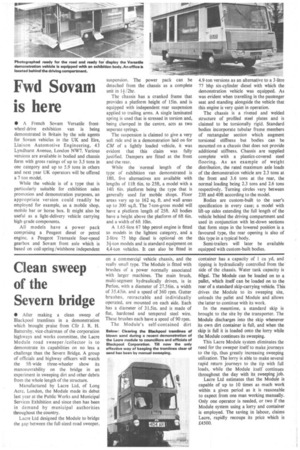Fwd Sayan' is here
Page 43

If you've noticed an error in this article please click here to report it so we can fix it.
• A French Sovam Versatile frontwheel-drive exhibition van is being demonstrated in Britain by the sole agents for Sovam vehicles in the UK and Eire, Liaison Automotive Engineering, 43 Lyndhurst Avenue, London NW7. Various versions are available in bodied and chassis form with gross ratings of up to 3.5 tons in one category and up to 5.9 tons in others and next year UK operators will be offered a 7-ton model.
While the vehicle is of a type that is particularly suitable for exhibition sales promotion and demonstration purposes, an appropriate version could readily be employed for example, as a mobile shop, mobile bar or horse box. It might also be useful as a light-delivery vehicle carrying high-grade components.
All models have a power pack comprising a Peugeot diesel or petrol engine. a Peugeot Transaxle four-speed gearbox and Sovam front axle which is based on coil-spring/wishbone independent
suspension. The power pack can be detached from the chassis as a complete unit in 1+ /211r.
The chassis has a cranked frame that provides a platform height of 15in. and is equipped with independent rear suspension applied to trailing arms. A single laminated spring is used that is stressed in torsion and, being clamped in the centre, acts as two separate springs.
The suspension is claimed to give a very soft ride and in a demonstration laid on for CM of a lightly loaded vehicle, it was evident that this claim was fully justified. Dampers are fitted at the front and the rear.
While the normal length of the type of exhibition van demonstrated is 18ft, five alternatives are available with lengths of 11ft 6in. to 25ft, a model with a 14ft 6in. platform being the type that is generally used for mobile shops. Floor areas vary up to 162 sq. ft. and wall areas up to 300 sq.ft. The 7-ton-gross model will have a platform length of 25ft. All bodies have a height above the platform of 6ft 6in. and a width of 6ft 10in.
A 1.65-litre 67 bhp petrol engine is fitted to models in the lightest category, and a 2-litre 75 bhp diesel is optional on the 3+-ton models and is standard equipment on 4.4-ton vehicles. It can also be fitted in 4.9-ton versions as an alternative to a 3-litre 77 bhp six-cylinder diesel with which the demonstration vehicle was equipped. As was evident when travelling in the pasgenger seat and standing alongside the vehicle that this engine is very quiet in operation.
The chassis is a riveted and welded structure of profiled steel plates and is claimed to be torsionally rigid. Standard bodies incorporate tubular frame members of rectangular section which augment torsional stiffness but bodies can • be mounted on a chassis that does not provide additional stiffness. Chassis are supplied complete with a plastics-covered steel flooring. As an example of weight distribution, the rated maximum axle loads of the demonstration vehicle are 2.3 tons at the front and 3.6 tons at the rear, the normal loading being 2.3 tons and 2.6 tons respectively. Turning circles vary between 23ft and 40ft according to the model.
Bodies are custom-built to the user's specification in every case; a model with lift-up sides extending the full length of the vehicle behind the driving compartment and used in conjunction with let-down sections that form steps in the lowered position is a favoured type, the rear opening is also of this type in a typical body.
Semi-trailers will later be available equipped with custom-built bodies.














































































































